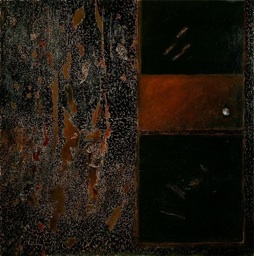"Steely Calm—Stefani Esta’s Steel and Stone Work Imposes a Meditative Serenity"
By Rick Deragon, Coast Weekly

"Steely Calm—Stefani Esta’s Steel and Stone Work Imposes a Meditative Serenity"
By Rick Deragon, Coast Weekly
"In her new two and three-dimensional work at the Monterey Museum of Art, Sand City-based artist Stefani Esta presents central focal points amid eddies of marks that result in serene experiences—meditative shelters in the storms of confusion.
Sheet metal wall pieces work like paintings, although they also have a sculptural presence with their two-inch depth, cutouts revealing subsurface layers, and concave bowl shapes breaking the picture planes. The stone sculptures generally follow the schema of the wall pieces, but with the central focal points existing within planes of polished stone rather than the skeins of marks. With muted, yet sumptuous color and overall surface elegance, the works aspire to, and achieve, a contemplative air.
There is much to recall the enveloping quietude of an Asian temple. The compositions’ centrality evokes the interiority of meditation. The compositions, designs of fields, squares and bands, recall the elegance of tapestry and vestment. And the stone sculptures, with their refined symmetry, work as much as altarpieces as then do activators of space. Moreover, kanji-like glyphs appear here and there, speaking in a provocative tongue
The color, rich but toned-down, is orchestrated around the impact of black; squares of gold, bands of cobalt blue and l=planes of oxblood red all speak to the black formality everywhere. Black’s cousin here, a deep, mottled rust orange, also serves as a reference, with color keyed to its earthy complexity.
One impressive feature of Esta’s wall pieces is the balance. On the one hand they have the visual (and actual!) weight of steel. On the other, the artist has so worked the material, through grinding, painting and cutting, that the work defies its source material. It’s too elegant to be sheet metal; the marks are too deft to be machine-generated; the rusty surfaces are too controlled to be weathered steel.
Balance also permeates the art thematically. One element plays off the other, and the inherent dialogue constitutes its message. For instance, "Luna," a 48-inch-square [sic! It is actually __inches square] wall composition, pits an area full of a thousand grinder marks against a broad, vertical band of flat black. A narrow band of busy orange and gold outlines the black element, protecting the serenity of night from the cacophonous marks raining down outside. A spherical moon shape emerges from the vertical black, a serene point serving as a foil for the disquietude of shimmering, exposed metal and peeling coppery paint opposite.
In several wall pieces, Esta utilizes the two-inch hollow below the picture plane by cutting through the surface steel to reveal a central motif. The effect is that one is readily drawn into the serene drama—to a glistening gold concave bowl amid a field of black, to the shadows lurking under her kanji-glyphs, to a spherical focal point that asserts itself like an inner light. "Spring," a large wall piece that takes a violently worked surface to create a restful effect, uses dominant black and a shower of grinder rents to create the magic of a late afternoon rain. "Spring" is anchored by two tree-like verticals, behind which fluid marks cascade diagonally. That the piece is black yet communicates day is perhaps due to the silvery dance that doesn’t duplicate as much as parallel the effect of raindrops falling through shadow’s, into puddles, across back-wet stones.
Three works, "Tao," "Long Life," and "Approach," have cuts in the surface that resemble the gestural marks of Chinese or Japanese writing. Centrally placed and embedded in either circular shapes or a vertical band, the "letters" pulsate with symbolic import. These obscure emblems of meaning garner strength because they exist in fields that can be read symbolically. Through horizontal bars, vertical bands, or open fields of oxblood red, Esta alludes to the larger forces of night and day, a gateway to resolution, the substance of which we are made. The faux characters’ cultural appropriations work visually and thematically because of the artist’s volition.
In "Threads of Truth," an imposing 48-inch by 48-inch wall piece, the artists offers a central sphere that practically vibrates with significance. Clothe in a small black room of a square, the sphere serves as a beacon emerging from the apparent void. Surrounding this motif, a sea of brilliant red surges with painterly marks. Narrow bands contain this red, as well as another, horizontal orange element and a tour de force cobalt blue strip that underscores the chromatic activity. Finally, a broad black band encompasses all this on the sides and bottom, suggesting a brilliantly colored tapestry draped in front of a black wall.
In the various works installed in the museum’s intimate Coburn Gallery, Esta has established a formal language that draws from the abstract painting of the last forty years. Surface texture, color resonance, the interaction of edges, the interplay of shapes, constitute her basic palette, but their use is personal. Her manipulation of sheet metal surfaces, her choices of colors and resins, and her design sense all work to create her own universe of believable signs."


“Luna” steel m/m